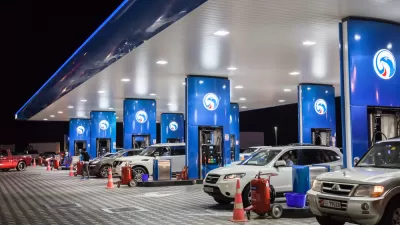A new report by the Eno Center for Transportation looks at the landmark five cent gas tax increase of 1982, more than doubling the existing tax, and explores its relevance to today's federal transportation funding crisis.
As Congress struggles to find funds to fill the $15 billion annual Highway Trust Fund shortfall between transportation spending and gas tax receipts, it may be beneficial to see how President Ronald Reagan not only ensured sustainable highway funding with the signing of the Surface Transportation Assistance Act of 1982 and companion Highway Revenue Act of 1982, but for the first time broadened the use of gas taxes to fund public transit by establishing a Mass Transit Account in the Highway Trust Fund.
Joshua Schank, Ph.D., President and CEO of Eno Center for Transportation, writes in the report's foreword [PDF] that the 1982 funding measure was the last time the gas tax was raised strictly for transportation purposes. The 5-cent and 4.3 cent gas tax increases signed by Presidents George H.W. Bush and Bill Clinton in 1990 and 1993 respectively, had "initially helped fund deficit reduction."
In this research, Jeff Davis, Eno Senior Fellow and Editor of Eno Transportation Weekly takes a closer look at how this ever happened. Jeff has conducted painstaking and groundbreaking research on this topic to help all of us better understand the circumstances that led to this remarkable event in 1982, and we can all learn something from what he has found. What we have learned may not enable anyone to engineer a tax increase, but hopefully it can thoughtfully inform all of us as we attempt to tackle this critical issue.
"As the legend goes, people of goodwill in both political parties saw a great national need and came together to find a politically challenging, bipartisan, common-sense solution," writes Davis in the overview. "The reality is a bit messier."
One of the many surprising aspects of the tax increase Davis divulges:
- Reagan’s decision to request a 5-cent-per-gallon gas and diesel tax increase in November 1982 was predicated on the assumption of an eventual devolution of a large part of the highway program back to states and on the understanding that the gas tax would not be used to finance “new starts” of subway systems.
Devolution is what many conservatives want today—eliminating the role of the federal government and turning it over to the states.
For those interested in how Reagan and Congress engineered one of the most significant increases of the federal gas tax since its inception in 1932, the Eno study should prove of great interest.
FULL STORY: Reagan Devolution: The Real Story of the 1982 Gas Tax Increase

Planetizen Federal Action Tracker
A weekly monitor of how Trump’s orders and actions are impacting planners and planning in America.

Maui's Vacation Rental Debate Turns Ugly
Verbal attacks, misinformation campaigns and fistfights plague a high-stakes debate to convert thousands of vacation rentals into long-term housing.

San Francisco Suspends Traffic Calming Amidst Record Deaths
Citing “a challenging fiscal landscape,” the city will cease the program on the heels of 42 traffic deaths, including 24 pedestrians.

Amtrak Rolls Out New Orleans to Alabama “Mardi Gras” Train
The new service will operate morning and evening departures between Mobile and New Orleans.

The Subversive Car-Free Guide to Trump's Great American Road Trip
Car-free ways to access Chicagoland’s best tourist attractions.

San Antonio and Austin are Fusing Into one Massive Megaregion
The region spanning the two central Texas cities is growing fast, posing challenges for local infrastructure and water supplies.
Urban Design for Planners 1: Software Tools
This six-course series explores essential urban design concepts using open source software and equips planners with the tools they need to participate fully in the urban design process.
Planning for Universal Design
Learn the tools for implementing Universal Design in planning regulations.
Heyer Gruel & Associates PA
JM Goldson LLC
Custer County Colorado
City of Camden Redevelopment Agency
City of Astoria
Transportation Research & Education Center (TREC) at Portland State University
Jefferson Parish Government
Camden Redevelopment Agency
City of Claremont



























